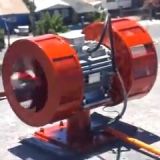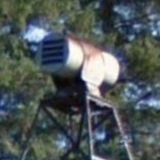List of miscellaneous "mystery sirens"
This list is meant to catalog sirens without a known manufacturer/origin ("mystery sirens") that do not have enough information about them to warrant a full article being made. These may be given pages if enough new information arises about them or their manufacturers. This list is only for miscellaneous sirens without a known manufacturer/origin; for a list of miscellaneous sirens with a known manufacturer/origin, see here.
Code designations
For ease of identification for sirens without confirmed names, locations, or colloquial names, most sirens documented on this list have code designations that correlate to the following.
Size of siren designation (1st letter):
- A = Large siren (Outdoor warning)
- B = Small siren (Vehicular, industrial, etc.)
Directionality of siren designation (2nd letter):
- C = Unidirectional
- D = Bidirectional
- E = Omnidirectional
- F = Rotational
Method of siren operation designation (3rd letter):
- G = Electromechanical
- H = Electronic
- I = Pneumatic
- J = Manual (hand crank, pedal, etc.)
For example, "AEG1" indicates that the siren is large, omnidirectional, electromechanical, and that it is the 1st siren on this list matching that descriptor to be documented on this list.
An image of the siren where it is clearly visible and of decent quality must be available for it to qualify for documentation on this list; an aerial image of the siren, or what is believed to be a siren, does not count. If the manufacturer/origin of a siren on this list is discovered, it will be moved to the list of miscellaneous sirens and its code will be retired. If a siren on this list is discovered to be a modification of a siren with a confirmed manufacturer/origin, it will be removed, and its code will be retired.
Red Mound, WI

A unidirectional electromechanical siren formerly existed in Red Mound, WI. The siren uses a 15″ 18-port rotor and 17″ stator, with the rotor and stator split into two sections. 2 beams are bolted to the front of the stator, covering the stator. The siren is driven by a 5 hp single phase Brook Motor Corporation electric motor located behind the stator, connected to the rotor through a clutch. The motor is likely not original to the siren, as it appears to be newer than the siren itself and runs at 3520 rpm, very fast for an 18-port siren. It is speculated that the original motor was an 1800 rpm motor, and the excessively high speed of the newer motor may have contributed to the siren's premature failure. The entire assembly is bolted to a large rectangular frame via several support beams, and the rotor has an external front bearing held by a cross shaped support bolted to the front of the stator. The origins of the Red Mound siren are unknown; it was likely shop-built by someone who derived inspiration from Denver or Sterling's products. The siren is in deplorable condition, with multiple serious cracks on the stator which would render the siren inoperable without major repairs. In addition, the rotor was found to be seized upon removal. The siren was rescued from its mount to be preserved in private possession in December of 2024. The name "Denver Fire Siren" is supposedly associated with this siren in some capacity but no documentation mentioning this name is known to exist.
Blawnox, PA
Bridgeton, MO
Dutch Flat, CA
Kulfonista siren
? (ADG1)

Multiple identical bidirectional electromechanical sirens exist in Chile, likely inspired by dual-rotor sirens of British origin like Carter & Co. (Nelson) or Castle Castings' products. These sirens use 2 9 and 12-port rotors and stators and are driven by a dual-side 3 ph motor most likely running on 380/400 V AC. Some versions of this siren have the motor bolted to a square plate with a vertical stand below it, attached to another plate from which the siren is bolted down from; this assembly allows for the siren to be bolted to a flat surface, typically the roof of a fire station. Due to the poorly balanced rotors, these sirens have a tendency to vibrate tendency to vibrate during operation resulting in a warbling sound; a video of 1 of these sirens during operation shows paint slowly being sheared off of the off-balanced rotors by the stators. These are locally used as fire sirens (the rotor, stator, and mounting assembly are all painted bright red which signify this) and most likely originate from a Chilean fire apparatus supplier which likely still makes the sirens. Similar sirens exist in nearby countries but are distinct in construction.
? (ADG2)

Multiple identical bidirectional electromechanical sirens exist in Quebec. These sirens use 2 rotors and stators and are driven by a dual-sided motor protected by a rounded motor cover. Both stators are shielded by cylindrical covers with 4 slots that allow sound to escape. The entire siren rests on a small trapezoidal platform. At least 1 of these sirens has large exponential horns attached to the rear of both stator covers. As these seem to be exclusive to Canada, it is likely that they were designed with frigid temperatures in mind and are heavily enclosed as such, making identification of further details difficult. These sirens have been described as similar in construction to the Sterling Model M and have been hypothesized to be modified Model M sirens: however, the fact multiple of these sirens exist which are all identical has since dispelled this theory.
? (ADG3)
At least 2 identical bidirectional electromechanical sirens exist in Quebec. These sirens use 2 rotors and stators and are driven by a dual-sided motor protected by a rounded motor cover. Both stators have small cylindrical intakes and are shielded by 2 large semi-circular sounder assemblies, with semi-circular lattice assemblies below each sounder. The entire siren rests on a simple base with 4 legs; the 2 legs on both sides of the siren are connected to square brackets which attach to the roof of a building. As these seem to be exclusive to Canada, it is likely that they were designed with frigid temperatures in mind and are heavily enclosed as such, making identification of further details difficult. These sirens have been described as similar in construction to the Federal Electric Type Mach. B and have been hypothesized to be modified Type Mach. B sirens: however, the fact multiple of these sirens exist which are all identical has since dispelled this theory.
? (ADG4)
This bidirectional electromechanical siren is Russian of origin and may have been inspired by dual-rotor sirens of British origin like Carter & Co. (Nelson) or Castle Castings' products. It uses 2 8 and 12-port rotors and stators with very thin port openings and is driven by a dual-side motor. The rotors have all long vanes and are protected by 2 covers with slots in-between several vertical bars that allow sound to escape. The motor has an eyebolt above it which allows for ease of installation and removal and is bolted to a plate with 4 legs below it that attach to a rectangular mounting frame that allows the siren to be bolted to a flat surface. Only 1 of these sirens is known to exist; alongside an original Type S-28 it is preserved at "Bunker 703", a former special storage facility for documents during the Cold War in Moscow.
? (ADG5)
At least 2 identical bidirectional electromechanical sirens exist in Pennsylvania, specifically Markleysburg, PA and Newell, PA. The sirens use 2 6-port rotors and stators with flanged horns on each side, and a vertical motor attached to a dual-shaft right angle gearbox drive to drive the rotors. Contrary to popular belief these do not utilize a rotation mechanism of any sort. These seem to have been sold as fire sirens as the only 2 known to exist are located at
? (ADG6)
? (BCG1)
? (BCH1)
Also named "Fire siren" from an eBay listing for a siren of this type. These use a speaker driver protected by a cylindrical cover and a flanged reentrant horn